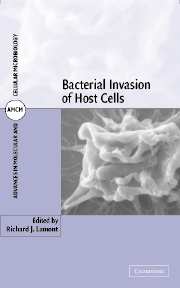Book contents
- Frontmatter
- Contents
- Contributors
- Preface
- Bacterial Invasion of Host Cells
- 1 Invasion mechanisms of Salmonella
- 2 Shigella invasion
- 3 How Yersinia escapes the host: To Yop or not to Yop
- 4 Stealth warfare: The interactions of EPEC and EHEC with host cells
- 5 Molecular ecology and cell biology of Legionella pneumophila
- 6 Listeria monocytogenes invasion and intracellular growth
- 7 N. gonorrhoeae: The varying mechanism of pathogenesis in males and females
- 8 Group A streptococcal invasion of host cells
- 9 Invasion of oral epithelial cells by Actinobacillus actinomycetemcomitans
- 10 Invasion by Porphyromonas gingivalis
- Index
- Plate section
- References
3 - How Yersinia escapes the host: To Yop or not to Yop
Published online by Cambridge University Press: 21 August 2009
- Frontmatter
- Contents
- Contributors
- Preface
- Bacterial Invasion of Host Cells
- 1 Invasion mechanisms of Salmonella
- 2 Shigella invasion
- 3 How Yersinia escapes the host: To Yop or not to Yop
- 4 Stealth warfare: The interactions of EPEC and EHEC with host cells
- 5 Molecular ecology and cell biology of Legionella pneumophila
- 6 Listeria monocytogenes invasion and intracellular growth
- 7 N. gonorrhoeae: The varying mechanism of pathogenesis in males and females
- 8 Group A streptococcal invasion of host cells
- 9 Invasion of oral epithelial cells by Actinobacillus actinomycetemcomitans
- 10 Invasion by Porphyromonas gingivalis
- Index
- Plate section
- References
Summary
The genus Yersinia contains three species of Gram-negative bacteria that are pathogenic for humans: Y. pestis, the agent of bubonic plague; Y. pseudotuberculosis, causing mesenteric adenitis and septicemia; and Y. enterocolitica, causing gastrointestinal syndromes (enteritis and mesenteric lymphadenitis). Bacteria from these three species have a tropism for lymphoid tissues and share the common capacity to resist the innate immune response. Whereas Y. pestis is generally inoculated by a fleabite or aerosol, Y. enterocolitica and Y. pseudotuberculosis are foodborne pathogens, which gain access to the underlying lymphoid tissue (e.g., Peyer's patches) of the intestinal mucosa through M cells (Fig. 3.1; see Autenrieth and Firsching, 1996; Perry and Fetherston, 1997). Once Yersinia has entered the lymphoid system, it overcomes the primary immune response of the host by using the type III secretion system (TTSS) (Cornelis et al., 1998; Cornelis, 2002). TTSS is a sophisticated virulence mechanism by which Gram-negative pathogens inject effector proteins directly into host cells. Currently, more than 20 different TTSSs have been described in animal, plant, and even insect pathogens (Hueck, 1998; Galan and Collmer, 1999; Cornelis, 2000; Buttner and Bonas, 2002).
Depending on the effectors injected, the employment of the TTSS will have a different outcome. Some, like the Mxi–Spa system of Shigella flexneri or the Salmonella pathogenicity island 1 (SPI-1) system of Salmonella enterica, make use of the innate immune system of the host to enhance the proinflammatory response and to trigger phagocytosis by normally nonphagocytic cells, whereas others, such as the pathogenic Yersinia Ysc–Yop system, essentially paralyze the innate immune response of the host (Galan, 2001; Sansonetti, 2001; Cornelis, 2002; Juris et al., 2002).
- Type
- Chapter
- Information
- Bacterial Invasion of Host Cells , pp. 59 - 86Publisher: Cambridge University PressPrint publication year: 2004



